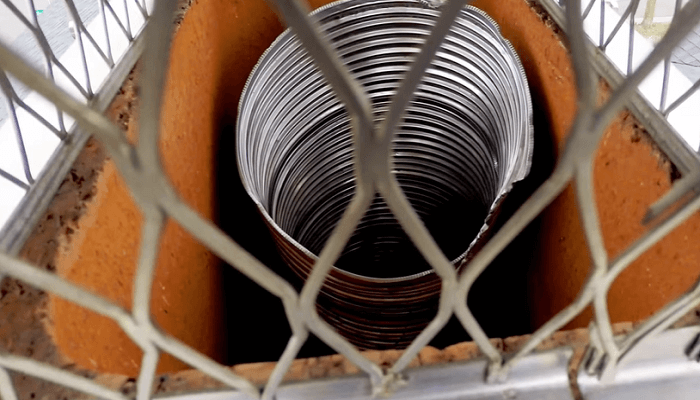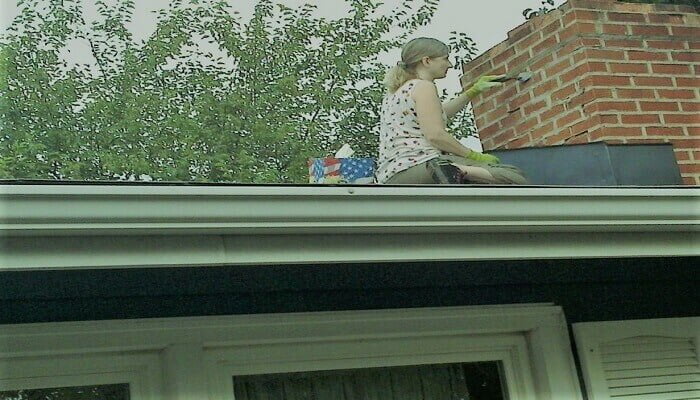Chimney Leak in Heavy Rain! How to Repair It?
Note: This article may contain affiliate links, which means if you make a purchase following our links won’t cost you extra, but we may earn a commission. Learn more
During the summer, the most common problem with homeowners is fireplace leaking water or chimney leaks in heavy rain. There are many reasons for this and there are many ways to solve it.
Although a leaking chimney repair isn’t difficult enough, neglecting them for long periods can lead to permanently significant, and dangerous structural damage. As well as chimney leaks water can enter your attic and ceiling, and rotting wood can damage roofs and drywalls. Whatever the case of chimney leaks, the results won’t be in your favor.
Scheduled inspections are essential, which can help detect any cracked chimney or chimney flashing leaks. If it can be detected early and there is no damage by then, you can repair the flashing rather than replace it completely.
Why Are Your Chimney Leaks in Heavy Rain?
There are many reasons for chimney leaks. Possible causes of how your chimney may leak include flashing damage, brick and mortar damage cracked chimney crowns, defective roof tiles, etc. These are possible causes we’ll discuss in detail.
1. If the Chimney Cap Isn’t Fitted Properly
The chimney cap is an important component of a chimney. This protects the top of the chimney from water intrusion as well as animals, and tree leaves and prevents rain, and snow slits from entering your chimney directly. Rainwater can enter the chimney and the fireplace if the chimney cap isn’t properly fit or installed.
2. If the Flashing Is Damaged
Flashing is made of a metal sheet of durable aluminum that is designed to seal the joints and prevent water from expanding into your chimney. It’s installed around your chimney stack. It can become worn out and damaged over time.

The way to inspect this problem is if you can see the chimney stack closely through your roof chimney or attic. If the flashing is installed incorrectly or is damaged, you’ll see signs of water leakage in this area in the chimney, or sunlight through any holes in the chimney stack or broken components. This can damage not only your roof and chimney but also the ceiling and even the walls around the chimney.
3. If Bricks and Mortar Are Damaged
If water enters the chimney brick or mortar, another possible cause of chimney leakage is created. Chimney bricks and mortar can be damaged by water entering. It can be understood by feeling the presence of a close-up view and ventilation.
4. When the Chimney Crown Cracked
If a chimney crown is cracked, the chimney may leak. The crown is placed on top of the chimney. The chimney crown is normally the piece of cement at the top of the chimney. If the crown is cracked or damaged, water will enter inside. It’s designed to stop rainwater from entering the chimney and causing damage to the chimney. A close-up view can confirm whether the chimney crown is cracked.
5. If Rain Enters Through the Top of the Chimney
If your chimney isn’t closed enough, it’ll allow rainwater to enter directly through the top of the chimney, causing the chimney to leak. If your chimney is open, you may notice that you may be able to see the rainwater directly after a heavy downpour.
6. If the Roof Tiles Are Defective
If the roof tiles are defective or missing, the chimney may leak. It’s not just limited to tiles near the chimney stack. This is because the junction of the chimney and the roof isn’t strong or there is still a separate weak area of your roof where the tiles may be defective or the tiles may be missing. Water can enter the chimney from such a place.
How to Identify a Leaking Chimney?
There are many signs to identify a leaking chimney, the presence of each of which will convince you that something should be done to your chimney. Some of the notable signs of a leaking chimney are –
First, The sound of water dripping from inside your chimney also determines the sign of a chimney leak. This problem presents itself more clearly in heavy rain. You just try to listen with deep attention.
Third, there is condensation in the fireplace, it can be a sign that your chimney is leaking. To find out the amount of condensation there you can place the back of your hand in that area with condensation and then measure it by comparing it to a dry part. A damp meter also can be used for this purpose.
Fourth, A simple calculation, if you see water in your chimney it’s because of the chimney leak. If you see a lot of water, it confirms an indication of a fatal leak. It’s very frightening, the moisture loss due to continuous water erosion can be severe and the bricks can fall apart. Also, this will increase the risk of carbon monoxide leaks, the poisoning of which can be fatal.
Fifth, You can also notice water leaks on the wall and signs of a chimney leak. Falling water can leave marks on walls.
Sixth, You can get the presence of smells in your chimney, especially after it rains, such as a musty smell or moisture. This may indicate a sign that there is a leak in your chimney.
Seventh, other possible causes include cracks in the masonry or interior plaster, cracked bricks, and damaged tiles. Each sign can be an indicator of one of your chimney leaks.
Leaking Chimney Repair
Chimney leak repair basically identifies and fixes the possible causes of chimney leaks. Above we have already discussed the possible causes of chimney leaks. Now we’ll discuss how to fix those factors.
1. Repair Damaged Flashing
If your chimney flashing is damaged, you need to repair it, in some cases, it should be replaced. If you want to repair the flashing yourself, use DIY flashing tape. And it’s best to hire a professional to fix or replace your damaged flashing. Because chimney flushing often requires replacement rather than repair, a professional can understand exactly what should be done.

2. Repair or Install a New Chimney Cap
If the chimney cap is damaged, repair it. If it doesn’t have a chimney cap, measure the flue tile at the top of the chimney, and buy the appropriate size chimney cap. Then install it as soon as possible following the manufacturer’s guidelines. In this case, you can take stainless steel caps.
3. Repair Damaged Bricks and Mortar
In most cases, bricks and mortars don’t have a way of repair, requiring replacement. So if any such problem is observed, take the help of a professional to make sure.
4. Repair Cracked Chimney Crowns
If you want to solve a cracked chimney crown problem yourself, you should use sealant to repair it. Wrap the chimney crown with a quarter of an inch of duct tape, pressing the tape into the vertical joints of the brick. Now also tap each flue liner 1 inch above the crown, and place canvas tarps around the base of the chimney to prevent any shingles from the crown sealer.
If the crack is relatively large it should be filled with patching cement or silicone caulk.
5. Repair Defective Roof Tiles
If the roof tiles are cracked, defective, or don’t have tiles, contact a professional to install the roof tiles correctly. Because you’ll need some suitable tools to replace your tiles, that they have.
You can also repair it yourself using cement or silicone caulking. But it may serve as a short-term solution.
How to Prevent Chimney Leaks?
It’s better to know how to prevent leaks than to know how to fix your chimney leaks.
Regular or annual chimney sweeps and inspections can often identify damage to a new chimney or masonry, giving you an idea to repair it (if necessary) before the chimney leaks.
Another great way to prevent leaks in your chimney is to waterproof your masonry. This process involves the application of a specially designed sealant and allows masons to retain their semi-porous nature and help keep water out.
You can also prevent leaks by regularly unblocking the gutters in your home. To do this, inspect your sewers regularly and keep them unblocked. This will help protect your chimney from water leaks.
Another way to keep your chimney running for a long time is to clean the chimney regularly and sweep it. This eliminates any debris, soot, and dust that accumulates along the chimney walls and keeps the inside of the chimney clean. Chimney sweeping should take the help of a professional. It will also allow you to repair the inside of your chimney if it is already damaged or at risk.
Conclusion
Never expect the presence of water in your fireplace chimney used for heating. As well as this your fireplace won’t work efficiently and it’s also harmful to your fireplace. Finding the source of the chimney leak isn’t difficult to fix, but it’s best to take preventive measures.
Here the causes of chimney leaks in heavy rain, leaking chimney repair, and how to prevent chimney leaks are all discussed. If you still can’t find a solution to your problem, contact a professional. Hopefully, you’ll spend time with your fireplace in your expected warmth.
Related Post:
- 10 Tips on How to Get More Heat From Your Gas Fireplace
- Gas Fireplace Smells Like Chemicals or Burning Plastic: How to Solve
To see our latest posts Click Here